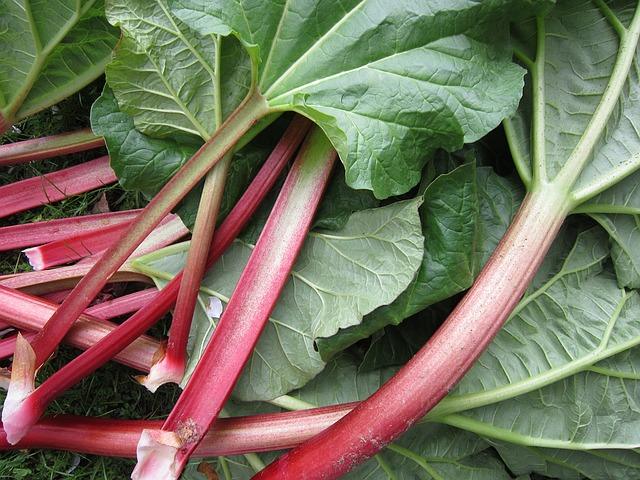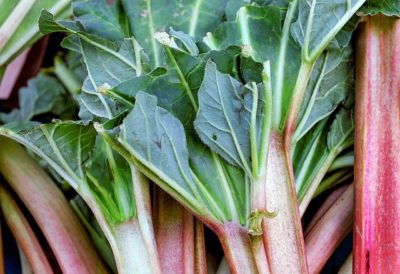There is more to rhubarb than meets the eye. You may know it as the edible perennial that pops up early in spring in yards all across the cooler regions of North America. Rhubarb is famous for its tart flavor, and is sometimes known as “pie plant” due to its frequent use in delicious pies.
But rhubarb has a surprising history. Recorded in Chinese documents as long as 2,700 years ago, rhubarb originated in the eastern hemisphere and was brought west by early spice traders. It was known to grow in what is now Russia along the banks of the River Volga, the regional word for what is believed to be the root for the word “rhubarb.”
The plant made its way to North America in the early 1800s via New England states and has spread across much of the continent.
The reason for the high value was not for food, but for medicine. Rhubarb root was valued for its laxative properties, having been used for that purpose around the world for centuries. In fact, WebMD states the following:
“Rhubarb is used primarily for digestive complaints including constipation, diarrhea, heartburn, stomach pain, gastrointestinal (GI) bleeding, and preparation for certain GI diagnostic procedures. Some people use rhubarb so they have to strain less during bowel movements; this reduces pain from hemorrhoids or tears in the skin lining the anal canal (anal fissures). Rhubarb is sometimes applied to the skin to treat cold sores.”
Not only does rhubarb continue to be a good natural remedy for intestinal maladies and cold sores, it contains the pigment “parietin,” a substance which has been shown to slow the growth of human cancer cells in studies with mice. In addition, rhubarb contains compounds which “seem to reduce blood glucose levels in diabetic mice.” (LaboratoryEquipment.com)
Get Your Non-GMO Strawberry And Onion Seeds Right Here!
Many sources even claim that rhubarb root can be used for dye, for coloring hair and other materials.
But if you are like me, you appreciate rhubarb for its taste and its ease of growing. In addition to rhubarb pie—by itself or paired with strawberries—this wonderful early-season treat can be eaten raw, with or without sugar. Many people enjoy rhubarb sauce, which is made by stewing cut-up stalks with sugar or other sweetener and enough water to keep it from sticking. I enjoy my rhubarb sauce cold with a hint of cinnamon, eaten as a side dish much the same as applesauce, but there are no rules.
Rhubarb is often combined with strawberries to make lovely jam. It also goes great in breads, cakes, crisps and muffins. Many people also enjoy fruit drinks and wine made with rhubarb. It can be canned as plain rhubarb sauce with sugar, or as a savory side called Victoria sauce which is a little like chutney. It freezes well, too, either blanched or raw.
Given the many amazing benefits of rhubarb, it is little wonder so many people grow it. If you would like to be among them, following are a few easy tips to help you get started.
Rhubarb, known in Latin as Rheum rhabarbarum, is actually a vegetable, even though it is generally treated as a fruit. We eat the stalk, or the petiole, of the plant, like we do with celery. The roots of the plant are rhizomes, which is a specific type of root that propagates underground.
Like all plants, rhubarb has distinct preferences as to the type of soil and care in which it thrives best, but it is not terribly picky overall. It likes soil which is rich, well-drained, well-fertilized, and a slight-to-moderate acid pH level of 5.5 to 7.0. Rhubarb does well in sun but not in overly hot conditions, and can tolerate some shade as well.
Your first crop of rhubarb can come from one of two sources. First, if you know someone who is getting ready to divide up the roots of their mature plant and has more than they need, that is the least expensive way to go and a perfectly adequate way of acquiring your own rhubarb. However, if you do not know anyone who has excess or it is not convenient to get it from them at the correct time—or if they do not have your favorite variety—you can buy it from a garden seed supply retailer.
Rhubarb should be divided and planted in early spring, as soon as the soil is able to be worked. To plant your new crowns, dig a separate hole for each crown, two to three feet apart. Add a generous helping of compost to each hole, as rhubarb plants are heavy feeders, leaving room for the entire crown to be submerged in the hole. Place the crown one to two inches below the surface, bud end up, and cover. Water well.
Delayed gratification is a component of many edible perennials, and rhubarb is no exception. In order to grow and maintain healthy plants, rhubarb should not be harvested at all the first year. The following spring, it can be harvested lightly for a very short period at the beginning of the season and then left alone. But by the rhubarb’s third year, it can be harvested throughout the entire season, up to 10 weeks. It will be apparent that it is time to stop harvesting when the new growth stalks are thin.
It is important to pull stalks rather than cut them, to prevent creating a large wound on the plant which could potentially allow fungus and disease to get into the plant.
Rhubarb leaves are toxic. Never eat them or feed them to animals. It is fine in compost, however.
Pull flowering stems as they emerge. The appearance of flowers may mean that the plant is ready to be divided, or that the plant is starved for nitrogen. If the cause seems to be the latter, side dress the plant with a good source of nitrogen. Avoid covering the tops of young plants, so as not to burn them or cause rot to the crowns.
If it is time to divide your rhubarb plants, do so in late fall or very early spring. Dig up the entire rhizome, taking care to keep as much of the root system intact as possible, and cut up with an ax or sharp spade, leaving at least one root and bud on each piece. You can re-plant the pieces yourself, or share them with others.
With a little care and attention, rhubarb is a crop which can last a lifetime. Whether appreciated it for its flavor raw or cooked, its enhancement of drinks and baked goods, or its medicinal qualities, rhubarb is a wonderful addition to any yard, garden, or homestead.
Sources:
Manley, Reeser, and Marjorie Perondo. The New England Gardener’s Year. Thomaston, ME: Cadent, 2013.
Smith, Edward C. The Vegetable Gardener’s Bible. North Adams, MA: Storey, 2000.
Every Spring, Gardeners Make This Avoidable Mistake — But You Don’t Have To. Read More Here.
 Off The Grid News Better Ideas For Off The Grid Living
Off The Grid News Better Ideas For Off The Grid Living





